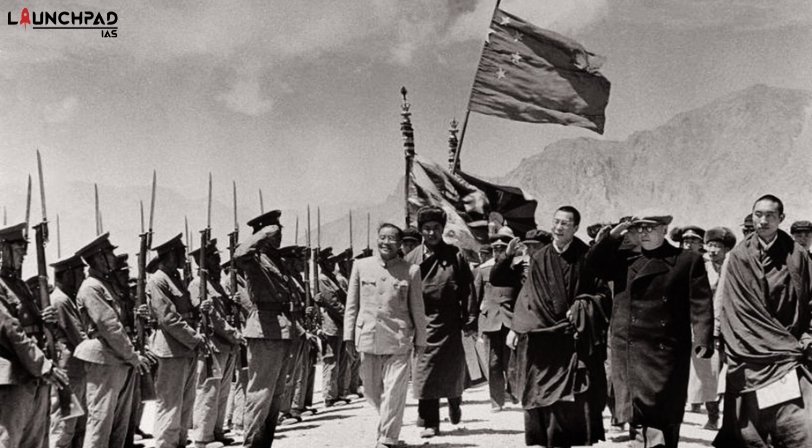- From 1912 until the founding of the People’s Republic of China in 1949, no Chinese government exercised control over what is today China’s Tibet Autonomous Region (TAR).
- The Dalai Lama’s government alone ruled the land until 1951. Tibet was not “Chinese” until Mao Zedong’s People’s Liberation Army (PLA) marched in and Invaded Tibet.
- In 1951 Tibetan leaders were forced to sign a treaty dictated by China. The treaty, known as the “Seventeen Point Agreement”, professes to guarantee Tibetan autonomy and to respect the Buddhist religion but also allows the establishment of Chinese civil and military headquarters at Lhasa (Tibet’s capital).
- However, the Tibetan people, including the Dalai Lama consider it invalid.
- This has often been described by the Tibetan people and third-party commentators as “a cultural genocide”.
1959 Tibetan Uprising:
- Escalating tensions between Tibet and China led to a critical turning point in 1959 when the Dalai Lama, along with a group of followers, fled to India, seeking asylum.
- Tibetans who followed the Dalai Lama formed an exiled government based in Dharamshala, India, known as the Central Tibetan Administration (CTA).

Aftermath of the 1959 Tibetan Uprising:
- Since the 1959 Uprising, the central government of China has been steadily tightening its grip on Tibet.
- In Tibet today, there is no freedom of speech, religion, or press and arbitrary detainments continue.
- Forced abortion, sterilization of Tibetan women, and the transfer of low-income Chinese citizens threaten the survival of Tibetan culture.
- Although China has invested in infrastructure improvements for the region, particularly in Lhasa itself, it has also encouraged thousands of ethnic Han Chinese to move to Tibet resulting in the demographic shift.
What is the Impact of Tibet and the Dalai Lama on India-China Relations?
- For centuries, Tibet was India’s actual neighbor, as most of India’s boundaries and the 3500km LAC (Line of Actual Control) are with the Tibetan Autonomous Region, and not the rest of China.
- In 1914, it was Tibetan representatives, along with the Chinese that signed the Simla convention with British India that delineated boundaries.
- However, after China’s full accession of Tibet in 1950, China repudiated the convention and the McMahon line that divided the two countries.
- Further, in 1954, India signed an agreement with China, agreeing to recognize Tibet as the “Tibet region of China”.
- The presence of the Dalai Lama in India has been a persistent irritant in India-China relations, as China considers him a separatist.
- The Tibetan plateau’s significance in terms of water resources and geopolitical considerations adds complexity to the India-China-Tibet equation.


